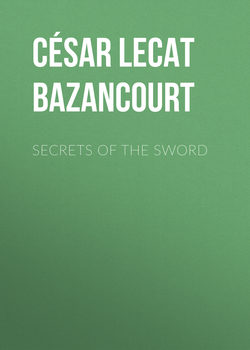Читать книгу Secrets of the Sword - César Lecat de Bazancourt - Страница 14
The Second Evening
III
Оглавление“My classification, you see, is not very complicated.”
“But,” some one objected, “you are surely forgetting to name an immense number of strokes and parries; for it is impossible that the long lists of names, which are given in the books, and the directions for the various passes, which have the air of cabalistic formulae and are about equally intelligible, can be reduced to such simple terms.”
“I am willing to forget them,” I replied, “in fact more than willing, for I am convinced that they only serve to distract the learner’s mind. The simpler the principles, the simpler the practice. Give him fewer things to do, and he will do them more easily, and he will certainly learn to do them in a shorter time.
“I have always said that a text-book of fencing, which contained nothing that was superfluous, would not fill a volume but might be written out on a sheet of notepaper, and besides, I would have you notice that several of the attacks, parries, and ripostes included in my list might logically have been omitted, because they are simply different ways of executing the same movement.
“For instance, what I have called “One, two” is the combination of two disengagements, one delivered in quarte, the other in tierce. The beat straight thrust is the combination of a beat on the sword with a straight thrust. The beat disengage is simply a beat followed by a disengagement. Feint cut-over, feint disengage are in like manner the different methods, which are most commonly used, of executing the straight thrust or the disengagement, the two fundamental strokes of sword-play.
“Even the cut-over is really a sort of disengagement, since it starts from the same position, is aimed at the same point, and may be met by the same parries. The only difference is that the disengagement passes under the blade, while the cut-over passes over the point. The cut-over and disengage in quarte is the same movement as counter-quarte, conceived and executed in the one case as an attack, in the other as a parry. Cut-over and disengage in tierce is related in precisely the same way to counter-tierce.
“You see, then, that the multiplication of strokes, far from extending to infinity, may be reduced to very narrow limits. And I am firmly convinced, that if you transgress these limits you are at once involved in endless confusion, which you ought to be very careful to avoid. – You will, I am sure, admit the force of my argument.
“The attacks and parries which I have described traverse all the lines which are open to the passage of the sword, that is to say the high and low lines, the inside lines and the outside. The fencer whose mind is set free from the perplexity of parries complete and parries intermediate and so forth, understands more clearly the materials that are available for his combinations, and the measures that he must take to meet the adverse attack.
“The lucidity of his mind is reflected even in the movement of his hand which goes straight to its mark without hesitation or confusion. Speed and freedom of delivery follow as a matter of course. And we must not forget that quickness of hand, combined with what may be called fencing judgment, is of all qualifications the most important, the most necessary, the most vitally indispensable.
